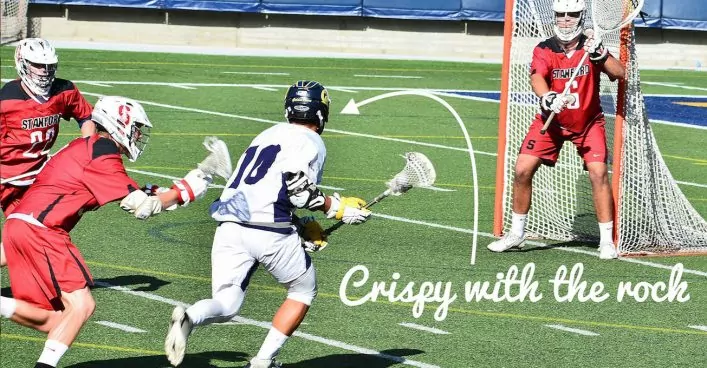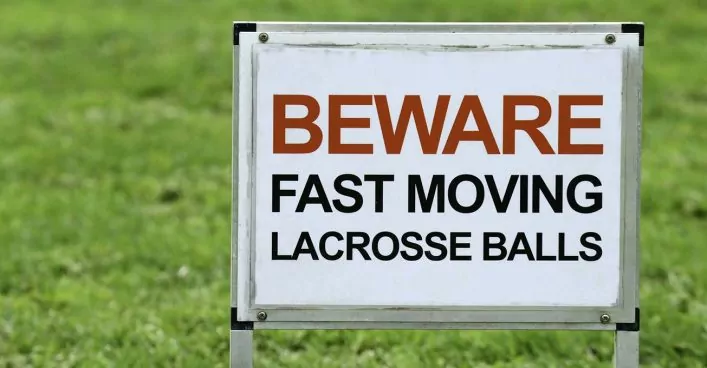Every time you raise to the next level of competition the caliber of players you face becomes way better.
On your youth team there might be one kid who can shoot hard. By the time you get to junior high, there’s a handful of kids who can bring the goods. Even more when you reach high school. And when you reach the college ranks nearly every kid can ping corners with speed.
Couple that with the fact that at this very moment the engineers at Brine, Warrior, and STX are working to create revolutionary products that put more whip, zip, and accuracy on each shot.
All of that leads me to an email I got from a high school goalie:
Coach – I’m a freshman in high school and it is my third year playing lacrosse goalie. I don’t have trouble saving slow-medium speed shots but I just am not able to get in front of those extremely fast shots especially at the high school level during practice. Do you have any tips on what I can do? Thank you!
On this blog we’ve already discussed:
But we’ve never specifically covered FAST shots!
In this post I’ll outline a few tips for goalies moving to next level who suddenly feel like they’re not equipped to handle the high velocity that your new opponents are bringing.
Focus on the Release Point
At younger levels many times you can get away with not immediately picking up the shot.
Without the velocity of higher levels you have more time to react. It’s more forgiving in that way.
At higher levels you really need to train to pickup the release point.

What’s the release point? It’s the exact moment the ball leaves the shooter’s stick.
Many goalies have their strategy for picking up the shot quickly. For me the best method – for an outside shot – is to focus on the release point.
Not the shooter, not the shooter’s eyes, the shooter’s release point.
This insane focus on picking up the release point will give you the maximum amount of time to see the shot and make your save movement.
You’ll need that when facing fast shots!
Step Back in the Arc
On the podcast I ask most goalies if their style has changed at all as they advanced from youth lacrosse to high school through college and then to the pro’s.
Most indicate that if they started their youth lacrosse career playing a high or medium arc, as they advanced they moved back in the goal – playing a flat arc.
Playing a flat arc gives you just a little more time to see those fast shots.
It may not seem like much but that extra .1 second to see the shot can allow you to get there.
Playing a flat arc allows helps with staying in the right position on the arc. Whereas a high/normal arcs have a lot of movement to get from top right to top left on the arc, a flat arc does not.
Get in Extreme Shape
Many goalies rely purely on athleticism when they’re young.
They’re able to make saves because they’re better athletes than the shooters.
But like I said as you move up in level – from JV to Varsity for example – you’re taking shots from kids who are much better athletes.
As a result, goalies need to step up the physical element of their game.
Jump rope, magic square, rope ladder, jump squats, sprints, resistance band exercises, etc.
Being in great physical shape will give your body that explosion you need to get in front of a 95mph step down.
Read ‘Em & Beat ‘Em
This is a concept I stole from the Goaliesmith brothers because – well – it’s pure genius.
The fact is when a lacrosse shooter is in tight, close to the goal (say <8 yards in the men’s game, <6 yards women’s) with their hands free, the odds are really in the shooter’s favor.
If you try to just pickup the shot out of the stick and then react, you have very little chance of saving that shot. There’s just not enough time.
In fact, lacrosse science did a special proving that those types of shots are literally unsaveable as the human body cannot react at the required speed to make that save.
So what do we do? Read ’em and beat ’em.
Read ’em involves analyzing the shooters body language for tips as to where he might shoot. Shoulder angled downward? Hands and stick dropping? Odds are that shot in coming low.
Shooters angled toward one side of the goal? Odds are that shot is going there.
Once you’ve read ’em, it’s time to beat ’em which means going early and beating the shot to that spot.
Will you misread some shots and give up goals? Sure.
But – will you also make some saves that you have no business making? Absolutely!
So if those “fast” shots are coming from within 8 yards you’ve got to remember the read ’em and beat ’em technique.
Practice with Good Shooters
Many rookie NFL quarterbacks when making the transition to the pros discuss that they’ve got to get used to “the speed of the game”.
Whereas in high school or college they may have a few seconds to hit an open receiver. In the pro’s that time is reduced to a fraction of a second.
Some goes for us goalies. We’ve got to get used to the speed of the game at the higher levels.
So practice at high speed. Practice with players better than you. Practice with guys who know how to shoot.
After a solid season of practice, drills, and games at high speed – all of a sudden those shots don’t seem as fast as they once were.
No Wasted Movement
Couple weeks ago I broke down some slow motion footage of a goalie making saves.
This goalie demonstrated one of the common mistakes you see young goaltenders make – wasted movement.
Whether that’s with a false step or dropping the hands before moving them to the shot – it’s a very common and innate thing for us goalies. Something I struggled with immensely as I was learning the position.
You might be able to get away with those mistakes when the shots are not fast.
In fact in that very video the young goalies saves every shot where she exhibits a wasted movement because the shots are not that hard and she can recover.
But high velocity shots are not forgiving!
Scotty Rodgers talks about having “one bullet in the chamber”.
You only get to fire it once and you’ve got to fire it directly at the shot. Or else those high velocity cranks are finding the back of the net.
A false step is firing twice and you can’t do that and be an elite goalie at the higher levels.
Check out this video clip:

This goalie ends up making the save, but notice the wasted movement? Top hand drops before moving to the ball.
He still makes the save, but if that shot is another 10MPH it’s in the back of the net.
If you don’t know if you have this problem, grab an iphone and tripod and film yourself making saves. Break down that video in slow motion. It will be extremely clear.
Conclusion
I remember when I was a young goalie we scrimmaged the Olympic Club which was loaded with D1 guys who’d just graduated college.
One dude fired a shot so hard I only heard it whizz by my ear.
As you get to the higher levels the players get better. So as goalies we’ve got to up own game accordingly!
While you might have been able to rely on pure athleticism as a youngster, if you want to save FAST shots you’ve got to dominate the fundamentals of making saves.
You got to pickup the release points right away. You’ve got to make no wasted movements. You’ve got to be an extreme shape to explode to the ball.
You might also try moving back on the arc just to give yourself that extra split second to see the shots.
Finally you’ve just got to get used to fast shots. They’re not going to shoot slower out of pity.
Until next time! Coach Damon
Anyone else got any tips for getting used to the higher velocity shots when you move up in the levels? Would love to heard about it down below in the comments.
###
Photo Credit








 14 Amazing Lacrosse Goalie DrillsAug. 1, 2024
14 Amazing Lacrosse Goalie DrillsAug. 1, 2024 Quick Guide To Lacrosse Slang TermsApril 14, 2025
Quick Guide To Lacrosse Slang TermsApril 14, 2025 Lacrosse Goalies Rules To KnowJune 28, 2022
Lacrosse Goalies Rules To KnowJune 28, 2022 Lacrosse Goalie Step-by-Step Guide to Getting RecruitedFebruary 6, 2022
Lacrosse Goalie Step-by-Step Guide to Getting RecruitedFebruary 6, 2022 18 Lacrosse Goalie Drills to Improve Your GameApril 24, 2025
18 Lacrosse Goalie Drills to Improve Your GameApril 24, 2025 7 Elements of a Great Lacrosse Goalie StanceAug. 1, 2020
7 Elements of a Great Lacrosse Goalie StanceAug. 1, 2020 12 Lacrosse Goalie Tips To Take Your Game to the Next LevelSeptember 10, 2024
12 Lacrosse Goalie Tips To Take Your Game to the Next LevelSeptember 10, 2024 STX Eclipse 3 Goalie Head ReviewApril 24, 2025
STX Eclipse 3 Goalie Head ReviewApril 24, 2025 Lacrosse Goalie WorkoutAug. 12, 2019
Lacrosse Goalie WorkoutAug. 12, 2019 The Basics of Making a SaveJune 29, 2021
The Basics of Making a SaveJune 29, 2021


















































I’ve never tried read and beat em so now I think my save precentage will go up. It’s crazy how one “small” thing can change a lot.
So true Liam! One ‘ah-ha’ moment on a certain technique or even something mentally can totally change a lacrosse goalie’s game!
Hi Damon! Do you have a link to the lacrosse science special on reaction time you wrote about?
Yep! Here you go – https://laxgoalierat.com/lacrosse-goalie-science/
Could you possibly do an article on reading shots and how to predict where shots are going? I’m a junior goalie at Gilman and I am awful at reading sticks and shooters body language. Most of the time, my saves are purely based on reaction time and hand speed alone. I am doing everything like practicing with elite shooters and training my eyes. I just can’t seem to predict where shots are going, other than like the easy ones like a shooter with his stick low on the run shooting.
Yeah – reading shooters body language is a good one.